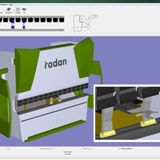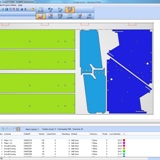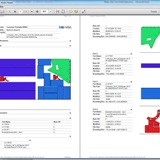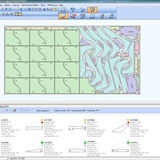Easier Multi-Tool Use in RADAN 2013
New developments in the 2013 release of the world’s most powerful sheet metal CAD/CAM software, RADAN, provide considerably improved support for multi-tools, meaning they are much easier to use.
RADAN General Manager Chris Aston says the traditional way of setting up multi-tools in the machine system data file is cumbersome and time-consuming. However, a major concept change in RADAN 2013 provides considerable support for multi-tools.
“We take the principle that a multi-tool is a tool, not a turret, which has implications as to how multi-tools are deployed by RADAN and configured and manipulated by users. In RADAN 2013 multi-tool configurations are deployed by taking the ‘variable (to buy)’ for the machine tool in question.
“For example, a configuration for a Trumpf machine will have the definitions – the shape and number of stations – of all multi-tools the customer may purchase for their machine tool, without allocating it to a tool station at that time. This is less work-intensive and more flexible than the traditional system of always allocating a multi-tool to a station.”
The combination of all enhancements in RADAN 2013 provides greater automation while still giving the user manual options if required. It contains key enhancements to the navigational tools, increasing accessibility to functions; along with improved integration of Radband; and the addition of colour making it easier to identify parts, both pre and post production.
Colour: Parts in nest projects now have colour assigned to them. In total 32 different colours are distributed over the items in the parts list. The nesting colours are also used when generating the setup sheet.
Nesting: Single Part Layout (SPL) has been integrated with nest projects. A new setting is available in the SPL dialog to specify whether or not to allow overproduction. Where multiple sheets are needed, SPL will generate a sheet count that will or will not satisfy the batch quantity. Where not enough parts are required to fill a sheet, if overproduction is not allowed the sheet will be left half-empty.
The SPL dialog can now be used to edit a nest produced by the automatic nester with only a single part on it, to modify clearances, etc., which has not been possible previously.
3D: Third-party file formats can now be imported by ‘dropping’ a file onto the 3D window. The resulting parts will be placed at the current work space. The user confirms the material before the import is completed, along with the thickness if this is not to be calculated automatically.
Radbend: New Radbend CAD interfaces for Inventor and SolidWorks have been introduced, so Radbend can be used a bend simulation tool for engineering.
RADAN 3D and Radbend: The improved connection between RADAN 3D and Radbend allows parametric programming of parts. After a change to the 3D model in RADAN 3D, the Radbend program (tool selection and fingerstop positioning) is automatically updated.
Single Click Selection: In RADAN 2013, geometry can be selected using just a single click. This new selection method can be used to copy geometry (jump to cursor) or grabbing parts.
Chris Aston says: “Extensive research and ongoing development ensures RADAN constantly enables users to gain the absolute maximum performance from their CNC machines and the CAM process for sheet metal, maintaining a competitive edge.”











